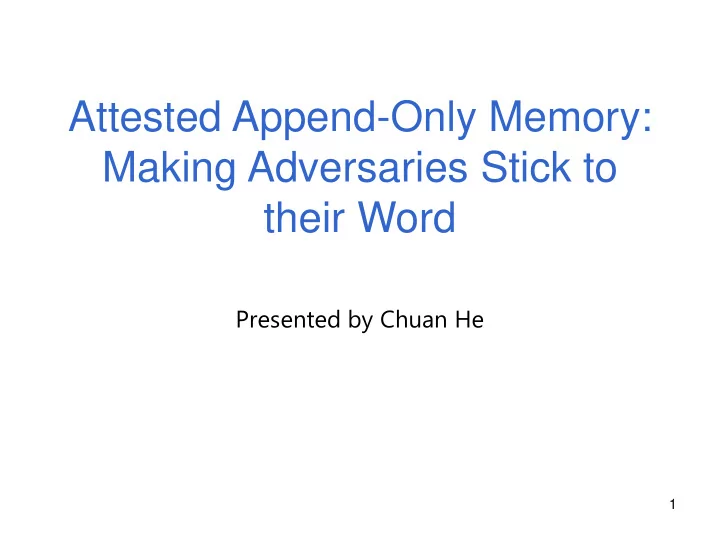

Attested Append-Only Memory: Making Adversaries Stick to their Word Presented by Chuan He 1
Talk Outline • Introduction and Motivation • Attested Append-Only Memory (A2M) • A2M Protocols • Evaluation • Conclusion 2
Motivation You want to build a service – Easy on a single machine – Replicate service on multiple machines • Replicated services must appear as single server – Linearizability: Completed client requests appear to have been processed in a single, totally ordered, serial schedule consistent with the order they were submitted 3
Motivation You want to build a service – Easy on a single machine – Replicate service on multiple machines • Replicated services must appear as single server – Equivocation: Different lies to different people 4
Servers Equivocating to Clients
Servers Equivocating to Servers
Questions • Does preventing equivocation help at all? – Can we improve upon the 1/3 Byzantine fault bound? • How do we prevent equivocation? – Is there any minimal system support? 7
Talk Outline • Introduction and Motivation • Attested Append-Only Memory (A2M) • A2M Protocols • Evaluation • Conclusion 8
Attested Append-Only Memory (A2M) • A set of numbered logs • Each log entry contains – Sequence number – Stored value – Crypto digest • lookup / end – Get a log entry – Attest (sequence number, value, history digest) – Attest freshness – Attest the end of log • append / advance – Cannot overwrite 9
Attested Append-Only Memory (A2M) • append / advance • Important feature – Cannot equivocate 10
Background: PBFT Execution Agreement Preprepare Prepare Commit Execute Primary s1 Quorum = 3 s2 req,resp s3 Reply s4 time [ 1,a ] Request Client1 [ 1,b ] Quorum: matching messages Client2 from different replicas 11
A2M A2M-PBFT-E (Execution) Preprepare Prepare Commit Execute Primary s1 Quorum = 3 s2 req,resp, Request log <seq,req,hist> s3 Reply s4 time Request Client1 Attested by A2M 12
A2M-PBFT-EA (2f + 1 replicas) Preprepare Prepare Commit Execute Primary s1 Quorum = 2 s2 req,resp, <seq,req,hist> s3 Reply time Request Client1 Attested by A2M 13
Protocol Trade-offs 1/3 PBFT 1/3 3f+1 2/3 A2M-PBFT-E 1/2 A2M-PBFT-EA 14
Evaluation Setup • Implemented A2M-PBFT-E and A2M-PBFT-EA • A2M protocols use signatures or MACs for authentication • Four replicas in a LAN. Each replica has its own A2M. • Microbenchmarks – Null operation with various request or response sizes • Macrobenchmarks: NFS – Software package compilation 15
Evaluation - Microbenchmarks
Evaluation - Macrobenchmarks
Varying delay time
Conclusions • Present A2M, a small trusted, log-based memory – Simple and easily implementable – Prevent equivocation • Improve fault tolerance by forcing servers to commit to a single history of operations – Improve fault bounds of BFT state machine replication – Achieve linearizability in an untrusted single-server system – The benefits are achieved with small performance overhead 19
Thank you! 20
Related Work • Weaken the guarantee – fork* consistency [NSDI07] – fork consistency [OSDI04] • Standard trusted hardware like TPM – does not improve the fault bound • Auditing – PeerReview [SOSP07], CATS [FAST07] • Shared file servers – SUNDR[OSDI04], Ivy [OSDI02], Plutus[FAST03] • Separating agreement from execution • Symmetric faults – hybrid fault model • Group communication 21
Recommend
More recommend